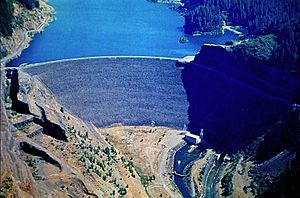Cougar Dam facts for kids
Quick facts for kids Cougar Dam |
|
|---|---|

Aerial view
|
|
| Location | Lane County, Oregon, USA |
| Coordinates | 44°7′44″N 122°14′25″W / 44.12889°N 122.24028°W |
| Opening date | 1964 |
| Operator(s) | Cenwp |
| Dam and spillways | |
| Impounds | South Fork McKenzie River |
| Height | 519 feet (158 m) |
| Length | 1,600 feet (488 m) |
| Reservoir | |
| Creates | Cougar Reservoir |
| Total capacity | 219,000 acre-feet (0.270 km3) |
| Catchment area | 210 square miles (544 km2) |
| Surface area | 1,280 acres (520 ha) |
The Cougar Dam is a huge rock-filled wall, about 519-foot (158 m) tall, located in Oregon, USA. It's like a giant plug that holds back the South Fork McKenzie River. This dam helps create electricity using the power of water, which is called hydroelectricity.
The dam has special gates called a spillway to let water out safely. It also has a building with two powerful machines called turbines. These turbines can make 25 megawatts of electricity, enough to power many homes!
Cougar Dam creates a large lake behind it called Cougar Reservoir. This lake can hold a lot of water, about 219,000 acre-feet (270,000,000 m3). The dam serves many important purposes. It helps control floods, makes electricity, improves water quality, provides water for farms, and creates habitats for fish and wildlife. It's also a place for fun activities like boating and fishing.
In 2005, a special building was added to the dam to control the water temperature released into the river. This helps protect fish like chinook salmon that need specific water temperatures to survive. Later, in 2010, the U.S. Army Corps of Engineers built a new facility to help collect and sort fish. This helps threatened fish like salmon and bull trout move safely past the dam.
Contents
Building Cougar Dam
Cougar Dam was finished in 1963. It cost about $54.2 million to build. The machines that make electricity, called turbine units, started working in 1964.
This dam works together with another dam, the Blue River Dam, to stop floods. Since it was built, Cougar Dam has prevented about $452 million in flood damage. That's a lot of money saved!
The dam itself is a long wall of rocks, about 1,500 feet (460 m) long. It has a special pipe called a penstock that carries water to power the turbines. There's also an emergency spillway, which is like a big drain, that can release a lot of water if needed. During construction, a tunnel was used to move the river around the building site. Once the dam was done, this tunnel was sealed with concrete.
Controlling Water Temperature
The original pipes that took water from the reservoir were very deep. This meant they pulled out water that was much colder than the surface water. When this cold water was released into the McKenzie River in spring and summer, it wasn't good for young salmon. They need warmer water to grow.
In the fall, when the reservoir level was low, warmer water from the surface would be released. This made salmon eggs hatch too early, which also harmed them.
To fix this, a new part was added to the dam's intake tower. It's a 302-foot (92 m) tall structure with three adjustable gates. These gates can mix water from different depths to get the right temperature. This mixed water then flows into the river. By controlling the water temperature, the dam helps protect the fish and the river's natural environment.
Helping Fish Move Safely
When Cougar Dam was first built, it had ways for fish to get past it. But over time, these didn't work as well. Fish stopped using them.
So, the Army Corps of Engineers decided to build a brand new facility to help fish. This new place cost $14.7 million. It includes a fish ladder, which is like a set of steps for fish to swim up, and a sorting area.
At this facility, adult salmon and bull trout are collected. They are then loaded onto trucks and moved to good habitats above the dam. This helps these threatened fish populations grow stronger and survive.
Upgrading the Turbines
The original parts of the turbines that spin and make electricity, called runners, got damaged over time. This damage, called cavitation, happens when tiny bubbles in the water collapse and wear away the metal. By the 1980s, the runners needed frequent repairs.
In 1987, new runners were installed. But by 2000, these new ones also started having problems. It was hard to fix them because the blades were thin and hard to reach.
So, the U.S. Army Corps of Engineers decided they needed a completely new and improved design for the turbines. They chose a company to build these new parts. In 2003, a contract was given to General Electric Hydro from Montreal, Quebec, Canada. The project was finished in March 2005.
The new project included testing models, installing new turbine runners, and completely rebuilding the turbine and generator parts. The problem with the old runners was that the water level in Cougar Reservoir changes a lot because it's used for flood control. This means the turbines had to work under very different water pressures, which caused the damage. The new turbines were designed to handle these big changes in water level much better.
In 2002, the reservoir level was lowered for the construction of the temperature control facility. This also gave a good chance to work on the turbine and generator units without the dam making electricity.

